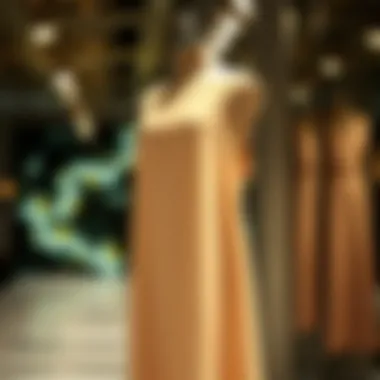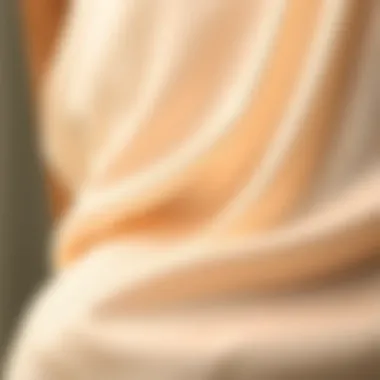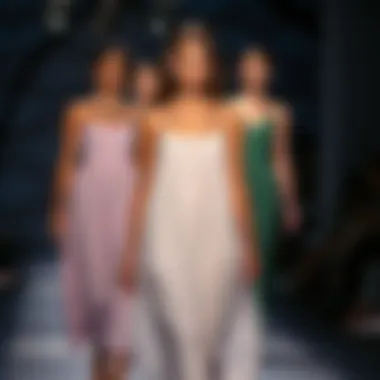The Timeless Appeal of the Plain Slip Dress


Intro
The plain slip dress has earned its stripes as a wardrobe staple, effortlessly bridging the gap between classic and contemporary fashion. With its sleek silhouette, this piece acts as a blank canvas, inviting creativity and personal expression. From its roots in lingerie to its rise in mainstream fashion, the slip dress has undergone a remarkable transformation over decades.
As we peel back the layers, we find that this seemingly simple garment harbors a rich history and an ever-evolving narrative. This article aims to dissect the slip dress’s past, its style journey, and offer practical styling advice to help elevate your personal aesthetic. By the end, you will see the slip dress not just as clothing, but as a versatile statement that can adapt to myriad occasions and express your unique style.
Fashion Tips
Styling Techniques
Dressing up or down a slip dress can hinge on a few simple techniques. First off, the key lies in the layering. A fitted turtleneck or a casual tee under a slip creates an interesting juxtaposition of textures and silhouettes. Another approach could be the addition of an oversized denim jacket or a tailored blazer, which adds structure and can transition the outfit from day to night with ease.
When it comes to fabric, consider materials like silk or satin for an evening look, while cotton or linen options are great for daytime. Don’t underestimate the power of subtle embellishments—consider using a belt to cinch the waist, creating a flattering silhouette.
- Experiment with different lengths; midi or even ankle lengths can provide a fresh twist to this classic.
- Pair with contrasting footwear; think chunky boots for an edgier vibe or strappy sandals for a delicate look.
Must-Have Accessories
Accessories can truly make or break the slip dress’s appeal. Here’s a quick rundown of essentials:
- Statement Jewelry: Chunky necklaces or oversized earrings can add personality to the minimalist design of the dress.
- Bags: A clutch for formal settings or a crossbody for a casual outing helps to ground the look.
- Footwear: Sneakers can evoke a fun, laid-back feel, while heels naturally elevate your ensemble.
Keeping your accessories in tune with the slip dress can forge a cohesive aesthetic. A well-chosen belt or scarf can bring a pop of color or texture, enhancing the dress's understated elegance.
"The beauty of a slip dress lies in its simplicity, yet it holds the promise of endless styling possibilities."
Outfit Inspiration
Seasonal Outfit Ideas
Each season presents distinct opportunities for slip dress styling. In spring, consider layering with a light cardigan and pairing with ankle boots; throw on a wide-brimmed hat for a touch of whimsy. Summer, on the other hand, can see you rocking the dress as a standalone piece with sleek sandals, perhaps adding a straw bag to reflect the sun-kissed vibe.
As the leaves turn, autumn invites layering with knits and adding structured outerwear. Finish with over-the-knee boots to keep warmth at bay while still looking chic. Finally, in winter, a longer slip dress paired with a turtleneck underneath, layered with a wool coat creates a sophisticated ensemble worthy of any gala.
Versatile Wardrobe Essentials
To harness the full potential of a plain slip dress, integrating it with versatile essentials can expand your styling options:
- Basic Tees: A simple white or black tee can transform the look instantly.
- Vests or Cardigans: Great for layering, adding warmth and interest.
- Footwear Variety: Having a selection from casual to formal completes your outfit for any event.
- Tights: Ideal for colder days to provide an extra layer without hindering style.
In summary, a plain slip dress remains a vital piece in a fashion-forward wardrobe. Its adaptability across seasons, ease of styling, and timeless allure make it a worthy investment for anyone looking to enrich their fashion landscape.
Intro to the Slip Dress
The slip dress, a staple in many wardrobes, embodies a unique blend of simplicity and sophistication. It’s not just another article of clothing; this garment plays a crucial role in contemporary fashion narratives. To understand its prominence, we must explore its definition, historical roots, and evolving role in women's fashion.
The beauty of the slip dress lies in its versatility. It serves as a canvas upon which personal style can be artfully draped. From casual daywear paired with a basic tee to an elegant evening ensemble enhanced by statement jewelry, the possibilities are as broad as one’s imagination allows. Furthermore, as fashion continues to move towards minimalism and sustainability, this garment stands out for its ability to transcend fleeting trends, making it an investment piece in any wardrobe.
Another aspect to consider is its adaptability to various body types and age groups. Whether you’re a young adult exploring personal style or someone well-versed in the fashion scene, the slip dress can be tailored to fit the occasion perfectly. This is crucial for both designers and retailers who aim to cater to a broad market while keeping a keen eye on consumer preferences.
In this article, we dig deeper into specific elements that define the slip dress, its historical context and evolution, and how it cultivates timeless elegance in an ever-changing fashion landscape. By the end, readers will gain insight into styling options, fabric choices, and care tips, ensuring they make the most out of this classic piece.
Defining the Slip Dress
A slip dress is characterized by its straight silhouette that hugs the body gently, typically featuring spaghetti straps and a simple neckline. It is designed for layering, creating an option for classic and elevated looks that can move seamlessly between different environments. What distinguishes this garment is not only its minimalist aesthetic but also the ease with which it can be styled; combine it with a blazer for work or wear it alone for a night out.
The silhouette’s simplicity puts focus on the fabric choice, which can range from luxurious silks to breathable cottons. Each fabric lends a distinct character to the dress, enhancing its elegance further. The slip dress stands as an embodiment of understated charm, encapsulating a modern yet timeless allure.
Historical Context and Evolution


The evolution of the slip dress is as layered as the garment itself. Originating from lingerie in the early 20th century, it was initially a practical undergarment, designed to create a smooth silhouette under dresses. Fast forward to the 1990s, the slip dress emerged as a pivotal trend in mainstream fashion, embraced by style icons like Kate Moss. This phase signified a cultural shift towards more gender-neutral attire and a fondness for sensuality wrapped in simplicity.
With the rise of minimalism, designers began to incorporate the slip dress into their collections as a key piece of their designs. Since then, it has made appearances on runways, solidifying its position as a go-to for fashion-forward individuals. Today, it persists in a variety of styles, embodying different themes, from bohemian chic to ultra-modern urban elegance.
The history of the slip dress serves as a reminder that wardrobe staples can evolve beautifully while retaining their core essence. As we move further into the 21st century, its adaptability continues to speak volumes about the ongoing significance of this piece, both in everyday fashion and high-end design.
Fabric Choices: The Foundation of a Slip Dress
When it comes to slip dresses, fabric choice is paramount. The fabric determines not only the dress's overall aesthetic but also its comfort and longevity. In a world of fast fashion, being discerning with fabric can elevate a simple slip dress into a standout piece in any wardrobe.
A slip dress can boast a variety of fabrics—from the elegance of silk to the long-lasting qualities of cotton. Each option presents its own set of benefits and considerations, appealing to different personal styles and occasions.
Silk and Satin: Luxurious Textures
Silk and satin embody luxury in every thread. These fabrics drape beautifully, creating an ethereal silhouette that enhances the wearer’s figure. Silk, being a natural fiber, offers a soft touch against the skin, which makes it ideal for any special occasion or evening affair. Its natural sheen catches the light, adding a touch of opulence.
Satin, on the other hand, though sometimes made from synthetic fibers, offers a similar luxurious look with added resilience. This makes it a favorite for those who desire a glamorous finish without the worry of delicate handling. Keep in mind that garments made from these fabrics often require a little extra care—think gentle hand washing or dry cleaning to maintain their pristine condition.
"Dressing in silk or satin can feel like wrapping yourself in liquid luxury."
Cotton and Linen: Casual Versatility
In contrast to the lavishness of silk and satin, cotton and linen bring a breath of fresh air with their casual vibe. These fabrics are breathable, making them perfect companions during the warmer months. A slip dress in cotton often feels easy-going; it allows for comfort without sacrificing style. Its durability means it can withstand regular wear, making it a practical choice for day-to-day wear.
Similarly, linen offers an effortless, laid-back aesthetic. While it wrinkles easily, the creases can often add to its charm, giving the garment a more relaxed look. Both fabrics are easy to accessorize, ideal for transitioning from a casual day out to a cozy evening gathering.
Synthetic Blends: Modern Innovation
Synthetic blends represent a marriage of comfort and performance. Fabrics like polyester are often blended with natural fibers to create a versatile option that combines the best of both worlds. These blends can add stretch and durability, ensuring that the slip dress maintains its shape and elegance over time.
Such fabrics often arrive treated for moisture-wicking properties, making them not only practical but suitable for various activities or occasions. This type of fabric choice is especially relevant for individuals who favor active lifestyles but still want to embrace the timeless elegance of a slip dress. Choosing a synthetic blend does not mean sacrificing style—just the opposite, in fact.
Styling the Plain Slip Dress
Styling the plain slip dress is an art unto itself. The inherent simplicity of this garment gives it a canvas-like quality, allowing wearers to express their individuality through various styling techniques. When done right, one can transition effortlessly from casual daytime looks to sophisticated evening attire. The beauty of the slip dress lies not only in its elegant silhouette but also in its versatility. By incorporating different layers, footwear choices, and accessories, you can create a myriad of outfits that suit various occasions.
Casual Daytime Looks
Layering with Tees and Jackets
Layering with tees and jackets is a standout technique for achieving a relaxed yet stylish daytime outfit. It combines comfort with effortless style, which is essential when navigating daily tasks or social gatherings. The key characteristic of this approach is the way it adds depth to the slip dress. By opting for a basic tee underneath or a denim jacket over the top, the plain slip dress can transform into a chic look for running errands or meeting friends for lunch.
A unique feature of this layering style is the play of textures. Pairing a silky slip dress with a cotton tee or a rugged outer layer creates a delightful contrast. This not only enhances the overall look but also serves a practical purpose—adding warmth on cooler days. However, one must be mindful of balance; over-layering can quickly lead to a weighed-down appearance.
Footwear Choices for Comfort
Footwear can make or break an outfit, and this rings especially true for casual day looks with a slip dress. Choosing comfortable footwear ensures you can enjoy a full day without wishing for the nearest couch. Sneakers or low-heeled sandals often complement the outfit, keeping the vibe relaxed. The footwear choice aligns perfectly with the overall goal of comfort without sacrificing style.
A significant aspect of this choice is the easy accessibility it allows. Slide-on mules or canvas shoes can be put on in a pinch, making them practical for the busy individual. However, one must consider the integrity of the slip dress while choosing shoes. Bulkier styles might thicken the silhouette, so one should aim for sleeker options.
Evening Elegance
Statement Accessories
When transitioning to evening wear, statement accessories take center stage. They have the power to elevate a plain slip dress into something that catches the eye and leaves an impression. The beauty of this styling method lies in its simplicity—just a few carefully chosen items can change the entire look.
The key characteristic of statement accessories is their ability to draw focus. A chunky necklace, bold earrings, or an oversized clutch can add a pop of personality against the basic backdrop of the slip dress. This method is beneficial because it allows individuality to shine through without overwhelming the elegance of the dress itself.
One unique advantage here is that statement pieces keep the slip dress from appearing too plain or uninspiring. However, it's vital to strike a balance. Too many accessories can detract from the subtle elegance the slip dress inherently possesses.
Optimal Footwear for Dressy Occasions


In the realm of evening elegance, the right footwear choices accentuate the slip dress perfectly. Heeled sandals or chic pumps can lend additional height and create an elongated silhouette, enhancing your overall appearance. Choosing elegant shoes can make one feel confident and poised.
The defining characteristic of optimal footwear for dressy occasions is their refined style. They often feature sleek lines and may include embellishments such as straps or metallic finishes. This elevates the overall look to a more sophisticated level.
However, while the allure of high heels is undeniable, comfort should not be forsaken. It's essential to choose footwear that can be worn throughout the event, ensuring that confidence shines through. Too much height or lack of support can result in annoyance, distracting from the joy of the evening.
Seasonal Adaptability
Winter Layers
Adapting the slip dress for winter involves layering effectively. Pairing it with thermal tights or turtlenecks is a popular trend that not only keeps you warm but adds an unexpected twist to the outfit. The key characteristic of this technique is versatility; it allows users to maintain their fashion identity even in the coldest months.
One unique aspect is the use of heavier materials, such as wool or cashmere, to layer under or over the slip dress. This method provides insulation while maintaining aesthetics. The potential downside is that it could make the outfit bulkier, so careful selection of layers is crucial.
Summer Breeziness
Conversely, achieving a summer-ready look with a slip dress is all about embracing its lightweight qualities. The characteristic of a slip dress shines in warm weather, allowing for a carefree, breezy vibe. This style typically includes simple sandals and minimal accessories to keep things fresh and airy.
A unique feature of summer styling is the chance to play with colors and patterns, which can bring a new dimension to the otherwise plain dress. Moreover, this seasonal adaptation is beneficial as it keeps you comfortable and stylish without feeling weighed down. However, one must be cautious of potential sun exposure and fabric choices, as lighter materials may be more susceptible to wear and tear.
"Styling a plain slip dress is not just about putting pieces together; it's a way to express your personal taste through every season."
In summary, mastering the art of styling a slip dress opens up endless possibilities for expression, offering practical solutions while maintaining a focus on comfort and elegance across a range of occasions and seasons.
Cultural Significance of the Slip Dress
The cultural significance of the slip dress stretches far beyond its simple design. It is a potent symbol of minimalism and femininity, embodying a lifestyle steeped in effortless elegance. As trends fluctuate and fashion cycles churn, the slip dress remains a steadfast piece cherished by many for its sheer adaptability and understated charm.
Symbol of Minimalism
In a world where excess often seems to reign, the slip dress stands as a quiet reminder of the beauty found in simplicity. Its lines are clean and its silhouette unembellished, emphasizing not just the wearer's body but their personal style. This aesthetic choice champions the notion that less is indeed more. By opting for a plain slip dress, individuals often project an image of confidence that doesn't rely on flashy details or complex patterns.
The garment is often associated with a lifestyle that embraces minimalistic principles — a movement that resonates well with eco-conscious fashion endeavors. In a society increasingly aware of its carbon footprint, the choice to opt for timeless pieces like the slip dress allows for a wardrobe that's both stylish and sustainable.
- Aesthetic Versatility: A slip dress can smoothly transition from a casual brunch to an elegant dinner with merely a change in accessories, demonstrating an adaptability that mirrors the minimalist lifestyle.
- Wardrobe Staple: Its neutral palette often makes it easier to pair with various garments or accessories, supporting the philosophy of creating a capsule wardrobe.
Representation in Popular Culture
The slip dress has carved a distinct niche in popular culture, often celebrated as a go-to ensemble for influential figures across generations. From the iconic looks of the 1990s — think Kate Moss or Jennifer Aniston — to present day fashion staples echoed by modern celebrities, its representation on-screen and in magazines has locked it in as a cultural touchstone.
The slip dress reappeared in many notable film scenes, capturing the essence of female character arcs that flirted with both vulnerability and power. Iconic films like Basic Instinct and The Hunger Games have showcased it as a tool for characters undergoing transformation.
Moreover, the slip dress's candid portrayal in various media reflects broader conversations about body image and self-acceptance. By donning this simple piece, women often feel liberated enough to embrace their shapes and celebrate their individuality.
"The slip dress is a canvas, allowing the personality of the wearer to shine through with each accessory and layer."
The blend of personal style and cultural representation continues to make the slip dress a favored choice among fashion designers and stylists looking to evoke a certain emotional response or narrative through clothing. Its power lies in the belief that elegance doesn’t need to shout; it can whisper delicately, demanding attention through its sheer presence.
Care Tips for Maintaining Your Slip Dress
Maintaining the plain slip dress involves more than just the occasional wash and hang. This garment, admired for its simplicity and elegance, requires a little extra care to keep it looking fresh and beautiful over time. Proper maintenance not only extends the life of your dress, but also preserves its shape and avoids the hassle of fabric wear and tear. Let's dive into how to effectively take care of your slip dress, so it continues to shine in your wardrobe for years to come.
Washing Guidelines
Hand Washing vs. Machine Washing
When it comes to washing your slip dress, the choice between hand washing and machine washing is crucial. Hand washing is often seen as the gentler approach, a kind of embrace for your delicate fabrics. The benefit here is control; you manage the water temperature and gently agitate the fabric, preventing excessive friction that machine washing can cause. The unique feature of hand washing is its ability to keep colors vibrant and fabrics intact. However, it can be time-consuming, especially if you're juggling a busy schedule.
On the flip side, machine washing offers convenience but requires a more cautious approach. You must select a gentle cycle along with cold water to ensure the dress doesn't lose its form. The key characteristic of this method lies in its efficiency, especially if you have several garments to clean. However, be aware that machine washing can lead to pilling or altering the dress's original shape if you're not careful.
Choosing the Right Detergent


Selecting the appropriate detergent is another important aspect of caring for your slip dress. It's tempting to grab the nearest bottle, but not all detergents are created equal. A gentle, mild detergent is typically the best friend of delicate fabrics; it prevents fading and maintains the material's integrity. The unique feature of the right detergent lies in its formulation, which helps to nourish the fabric instead of stripping it away.
If you're looking for a popular and effective choice, opt for one labeled as suitable for delicates or for colors. This not only ensures that your dress remains in pristine condition but also signals to your wardrobe that it deserves nothing short of the best. Still, some detergents can contain harsh chemicals that may lead to unexpected damage, making it essential to read the label carefully.
Storage Recommendations
Hang vs. Fold
Storing your slip dress is another vital step in prolonging its life. The debate of hang vs. fold comes into play here. Hanging your slip dress helps it retain its shape and avoids unsightly creases. Generally, a padded hanger is recommended to offer that additional support, which protects the fabric from stretching or tearing. However, be cautious as heavy fabrics might stretch out over time when hung for too long.
Conversely, folding is an option for those with limited hanging space, but it’s essential to do it properly. Use clean tissue paper between the folds to minimize creasing and wear. The choice here is entirely dependent on personal preference and space availability.
Preventing Fabric Damage
Preventing fabric damage isn’t just about being careful; it’s about being proactive. The slip dress's fabric is often delicate and can easily fall victim to snags, fading, or even discoloration. One effective strategy is to store it away from direct sunlight, as prolonged exposure can fade colors. A cool, dark area is best for keeping your dress fresh.
Additionally, be mindful of any accessories that could snag the fabric while wearing it. Sharp jewelry or rough fabrics can cause damage during wear, so it's wise to choose wisely. Regular inspections for loose threads or delicate spots can also prevent small issues from turning into big problems.
Maintaining your slip dress is not just about aesthetics; it’s a way to honor the craftsmanship that went into creating such a timeless piece. With these care tips at hand, your slip dress can stay as elegant and striking as the day you first wore it.
The Slip Dress in a Sustainable Wardrobe
The plain slip dress is often overlooked when discussing sustainable fashion, yet its role in creating a mindful wardrobe is undeniably significant. This elegant staple exemplifies how style can harmonize with environmental consciousness. Its versatility means it can be worn across seasons and occasions, which means investing in a high-quality slip dress can reduce the need for multiple garments that may only see limited wear. Here, we explore the essence of choosing an ethical slip dress and how its timeless nature contributes to sustainable fashion practices.
Choosing Ethical Brands
When selecting a slip dress, the brand behind it plays an important role in promoting sustainability. Today’s consumers are becoming more aware of the origins of their clothing and the impact their purchases have on the planet. Ethical brands often prioritize fair labor practices, eco-friendly materials, and responsible production methods. Look for brands that:
- Use organic and sustainable fabrics مانند Tencel or organic cotton.
- Clearly articulate their ethical practices regarding labor and sourcing.
- Engage in efforts to minimize waste, such as limited production runs or recycling initiatives.
Supporting these brands not only contributes to a sustainable wardrobe but also sends a message that conscious consumption matters. You might consider checking out resources like Fashion Revolution or the Good On You app to find brands that align with ethical practices.
Timelessness as a Sustainability Factor
A major aspect of sustainable fashion is the concept of timelessness. The plain slip dress stands as a symbol of enduring style that transcends trends. Unlike fast fashion items that are often discarded after a season, a well-made slip dress can remain in one’s wardrobe for years and can be styled in numerous ways.
The benefits of timelessness include:
- Reduced Consumption: By choosing timeless pieces, you decrease the likelihood of frequent wardrobe overhauls, thus reducing waste.
- Classic Versatility: A slip dress can be paired with various accessories, from a denim jacket for a casual look to statement jewelry for elegant outings, ensuring it's adaptable throughout the years.
- Long-Lasting Quality: Investing in a high-quality slip dress often means better materials and craftsmanship, which can lead to a longer lifespan for the garment.
Timeless pieces such as the slip dress encourage individuals to make thoughtful choices in their shopping, fostering a more sustainable approach to fashion overall. They remind us that elegance doesn’t have to weigh heavily on the environment. > "A slip dress may just be fabric, but the choice to wear one ethically can ripple out into a world of sustainability."
Closure: The Enduring Appeal of the Plain Slip Dress
The plain slip dress continues to hold a significant place within fashion, embodying a blend of simplicity and sophistication. Its ongoing relevance arises not merely from its aesthetic appeal but rather from its multifaceted nature, adaptable essence, and cultural resonance.
Versatility and Timelessness
One of the most striking features of the plain slip dress is its versatility. It crosses over boundaries of occasion and season, effortlessly slipping into both casual and formal settings. Pairing it with a denim jacket for a relaxed brunch or elegant heels for an evening affair enhances its adaptability. As a result, it becomes a staple that defies the fashion cycle, allowing individuals to invoke their personal style without forfeiting comfort.
Economic and Ethical Considerations
In today's world, individuals increasingly prioritize sustainable fashion choices. The slip dress, with its minimal fabric requirements, can often be constructed from eco-friendly materials. Moreover, investing in a quality slip dress promotes a sustainable wardrobe by reducing the need for frequent replacements. Its enduring style means it remains in fashion, reinforcing the argument that buying less, but of better quality, is a smart practice.
Cultural Connections
The slip dress is more than just clothing; it represents a cultural statement. This garment continues to be a canvas for individuality, allowing a woman’s personality to shine while still embracing the essence of a modern minimalist aesthetic. The recurring appearance of the slip dress in various cultural contexts, from films to art exhibits, underscores its integral role as a fashion symbol. It has, perhaps, become synonymous with a lifestyle that prioritizes ease without sacrificing grace.
Closure
As we reflect on the enduring appeal of the plain slip dress, it’s evident that this simple piece of clothing offers profound significance. It invites wearers to express themselves while remaining grounded in elegance. The slip dress's ability to adapt, survive, and thrive through evolving fashion trends speaks volumes about its place in the sartorial landscape. For designers, stylists, and fashion enthusiasts alike, the plain slip dress is more than mere fabric; it’s a celebration of timeless elegance that continues to inspire and influence.
"Fashion is what you buy, but style is what you do with it."
In wrapping up this exploration, those who embrace the classic slip dress can appreciate it as both a practical choice and an emblem of contemporary fashion that will likely withstand the test of time.
For more insights on fashion history and trends, resources such as Wikipedia and Britannica provide valuable backgrounds.















